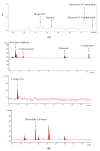Antimicrobial and Antiviral Compounds of Phlomis viscosa Poiret
- PMID: 36830977
- PMCID: PMC9953047
- DOI: 10.3390/biomedicines11020441
Antimicrobial and Antiviral Compounds of Phlomis viscosa Poiret
Abstract
Phlomis viscosa Poiret (an evergreen shrub) represents a valuable source of medicinal compounds. In this study, we discovered compounds with antimicrobial and antiviral properties. The aim of this study was to identify compounds of P. viscosa and estimate the antimicrobial and antiviral activity of its phytochemicals. The volatile compounds were identified using gas chromatography/mass spectrometry (GC/MS) analysis. For the identification of nonvolatile components of the extracts, high-performance liquid chromatography (HPLC), liquid chromatography-electrospray ionization-mass spectrometry (LC-ESI-MS) and matrix-assisted laser desorption/ionization-time-of-flight mass spectrometry (MALDI-TOF-MS) were applied. Quercetin 3-O-rutinoside and hesperidin caused a significant decrease in the bacterial concentration of Agrobacterium tumefaciens, Xylella fastidiosa and Pseudomonas syringae (p < 0.001). The growth of drug-resistant microorganisms (Escherichia coli, Klebsiella pneumoniae, Acinetobacter baumannii, Serratia marcescens and Salmonella enteritidis) was inhibited by quercetin 3-O-rutinoside, quercetin 3-O-arabinoside and hesperidin. In addition, these compounds demonstrated antiquorum-sensing properties. Diosmin, hesperidin and quercetin 3-O-arabinoside significantly inhibited varicella zoster virus (VZV) (p < 0.001). Quercetin 3-O-rutinoside and quercetin 3-O-arabinoside were effective against herpes simplex virus 1 (HSV-1), including mutant strains.
Keywords: Phlomis viscosa; antimicrobial compounds; antiviral compounds; biofilm formation; drug-resistant microorganisms; flavonoids.
Conflict of interest statement
The authors declare no conflict of interest.
Figures





Similar articles
-
Therapeutic Potential of Ficus benjamina: Phytochemical Identification and Investigation of Antimicrobial, Anticancer, Pro-Wound-Healing, and Anti-Inflammatory Properties.Molecules. 2025 Apr 28;30(9):1961. doi: 10.3390/molecules30091961. Molecules. 2025. PMID: 40363768 Free PMC article.
-
Medicinal Properties of Anchusa strigosa and Its Active Compounds.Molecules. 2022 Nov 25;27(23):8239. doi: 10.3390/molecules27238239. Molecules. 2022. PMID: 36500332 Free PMC article.
-
Effect of Bioactive Phytochemicals from Phlomis viscosa Poiret on Wound Healing.Plants (Basel). 2019 Dec 16;8(12):609. doi: 10.3390/plants8120609. Plants (Basel). 2019. PMID: 31888128 Free PMC article.
-
Forced degradation and impurity profiling: recent trends in analytical perspectives.J Pharm Biomed Anal. 2013 Dec;86:11-35. doi: 10.1016/j.jpba.2013.07.013. Epub 2013 Jul 31. J Pharm Biomed Anal. 2013. PMID: 23969330 Review.
-
Screening of synthetic PDE-5 inhibitors and their analogues as adulterants: analytical techniques and challenges.J Pharm Biomed Anal. 2014 Jan;87:176-90. doi: 10.1016/j.jpba.2013.04.037. Epub 2013 May 6. J Pharm Biomed Anal. 2014. PMID: 23721687 Review.
Cited by
-
Therapeutic Potential of Ficus benjamina: Phytochemical Identification and Investigation of Antimicrobial, Anticancer, Pro-Wound-Healing, and Anti-Inflammatory Properties.Molecules. 2025 Apr 28;30(9):1961. doi: 10.3390/molecules30091961. Molecules. 2025. PMID: 40363768 Free PMC article.
-
Flavonoids with Anti-Herpes Simplex Virus Properties: Deciphering Their Mechanisms in Disrupting the Viral Life Cycle.Viruses. 2023 Nov 29;15(12):2340. doi: 10.3390/v15122340. Viruses. 2023. PMID: 38140581 Free PMC article. Review.
-
Research Progress on the Antibacterial Activity of Natural Flavonoids.Antibiotics (Basel). 2025 Mar 22;14(4):334. doi: 10.3390/antibiotics14040334. Antibiotics (Basel). 2025. PMID: 40298463 Free PMC article. Review.
-
Etrog Citron (Citrus medica) as a Novel Source of Antimicrobial Agents: Overview of Its Bioactive Phytochemicals and Delivery Approaches.Pharmaceutics. 2025 Jun 9;17(6):761. doi: 10.3390/pharmaceutics17060761. Pharmaceutics. 2025. PMID: 40574073 Free PMC article. Review.
-
Bioprospecting phytochemicals of Rosmarinus officinalis L. for targeting SARS-CoV-2 main protease (Mpro): a computational study.J Mol Model. 2023 Apr 28;29(5):161. doi: 10.1007/s00894-023-05569-6. J Mol Model. 2023. PMID: 37115321 Free PMC article.
References
-
- Mathiesen C., Scheen A.-C., Lindqvist C. Phylogeny and biogeography of the lamioid genus Phlomis (Lamiaceae) Kew Bull. 2011;66:83–99. doi: 10.1007/s12225-011-9257-0. - DOI
LinkOut - more resources
Full Text Sources
Molecular Biology Databases
Miscellaneous

